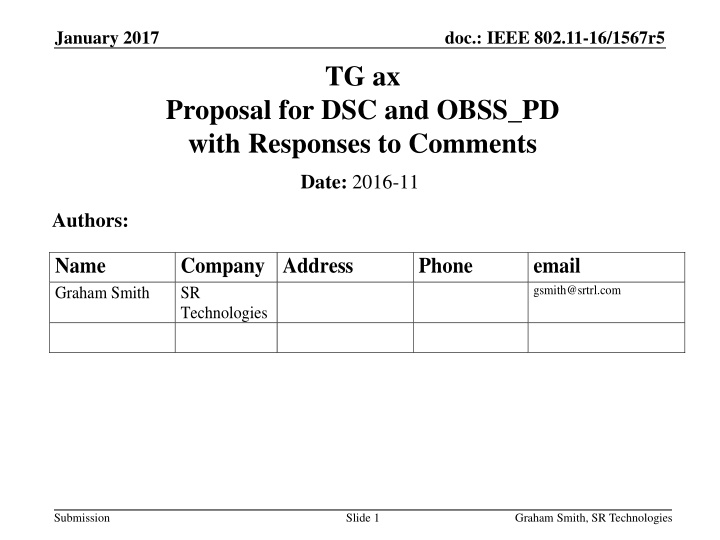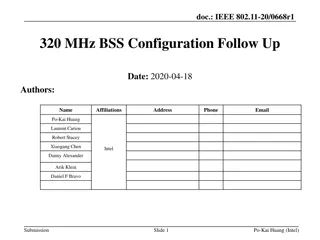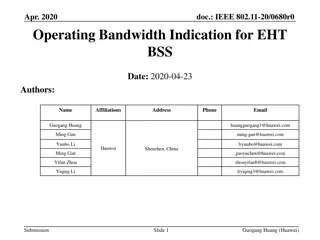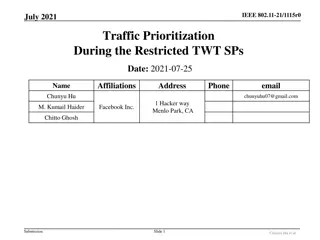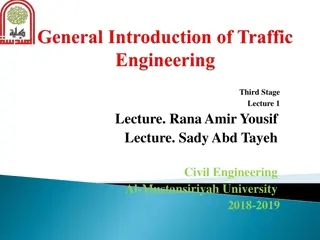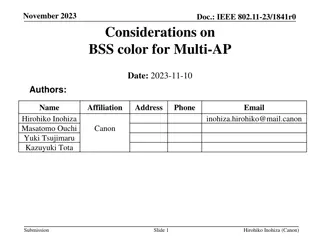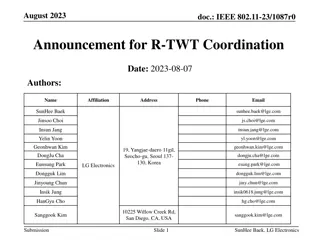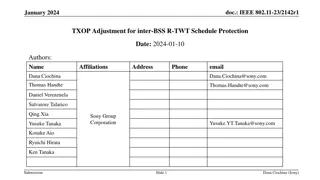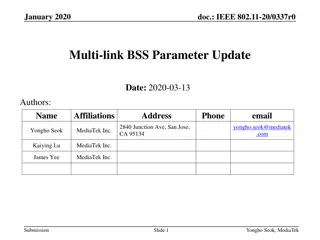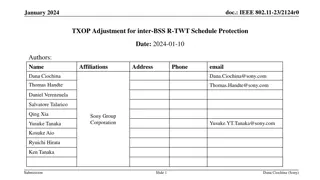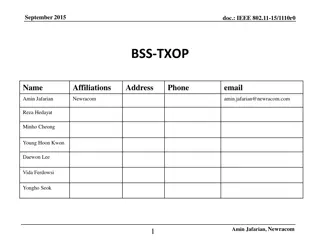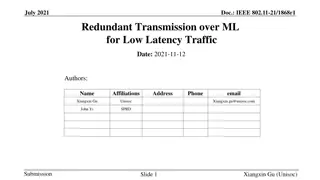IEEE 802.11-16/1567r5 TG.ax Inter-BSS Traffic Handling Proposal
This content explores a proposal for handling inter-BSS traffic in an IEEE 802.11-16/1567r5 TG.ax context. The document discusses Dynamic Sensitivity Control (DSC) and Transmit Power Control (TPC) mechanisms along with responses to comments. Various schemes for Spatial Reuse are presented, including Color/inter-BSS, TPC adjustments based on CS/CCA threshold, and DSC for adjusting CS/CCA threshold based on AP beacon RSSI. The document also addresses the issue of distinguishing between inter-BSS and intra-BSS packets in the context of OBSS_PD.
Download Presentation

Please find below an Image/Link to download the presentation.
The content on the website is provided AS IS for your information and personal use only. It may not be sold, licensed, or shared on other websites without obtaining consent from the author.If you encounter any issues during the download, it is possible that the publisher has removed the file from their server.
You are allowed to download the files provided on this website for personal or commercial use, subject to the condition that they are used lawfully. All files are the property of their respective owners.
The content on the website is provided AS IS for your information and personal use only. It may not be sold, licensed, or shared on other websites without obtaining consent from the author.
E N D
Presentation Transcript
January 2017 doc.: IEEE 802.11-16/1567r5 TG ax Proposal for DSC and OBSS_PD with Responses to Comments Date: 2016-11 Authors: Name Graham Smith Company Address SR Technologies Phone email gsmith@srtrl.com Submission Slide 1 Graham Smith, SR Technologies
January 2017 doc.: IEEE 802.11-16/1567r5 Background 16/1064 proposed a unified approach to optionally use DSC to derive the OBSS_PD for the other two schemes. In 16/1519 Report from 11ax dominance investigation comments on DSC by other members were included. These are addressed. Three basic Spatial Reuse schemes have been proposed: Color/inter-BSS (in D1.0) Identify traffic in an OBSS network, inter-BSS packets Ignore inter-BSS packets if below an OBSS_PD value TPC (in D1.0) Adjust the transmit power of a STA based upon the CS/CCA threshold of the STA i.e. STA can increase CS/CCA threshold if it also reduces TXPWR DSC (not in D1.0) Adjust the effective CS/CCA threshold of a STA based upon the RSSI of the network AP Beacons Submission Slide 2 Graham Smith, SR Technologies
January 2017 doc.: IEEE 802.11-16/1567r5 Inter-BSS, Intra-BSS and OBSS_PD Inter-BSS packets Traffic in an OBSS network to the STA Intra-BSS packets Traffic in the same network as the STA Basic idea If packet is identified as inter-BSS, ignore it if below a certain signal level, OBSS_PD Do not set NAV, Can transmit over it BUT must adjust TXPWR No procedure or description on how to set OBSS_PD Submission Slide 3 Graham Smith, SR Technologies
January 2017 doc.: IEEE 802.11-16/1567r5 TPC Transmit Power Control Reduce transmit power so that interference to OBSS is reduced Adjust OBSS_PD level in conjunction with Transmit power From 16/1233r6 No procedure or description on how to set OBSS_PD A STA can select an OBSS_PD level during its operation under SR mode. This level can be dynamically adjusted or can be static. Submission Slide 4 Graham Smith, SR Technologies
January 2017 doc.: IEEE 802.11-16/1567r5 DSC Dynamic Sensitivity Control (13/1012, etc) Adjust STA effective CS/CCA threshold based upon RSSI of wanted beacon from AP CCAeff = MIN (Upper Limit, RSSI beacon ) Margin CCAeff min = -82 dBm for 20 MHz. AP can advertise DSC Margin and Upper Limit to set the area of its BSS. STA can implement DSC (within limits) unilaterally AP can inhibit DSC (in case of outdoor, long distances for example) Submission Slide 5 Graham Smith, SR Technologies
January 2017 doc.: IEEE 802.11-16/1567r5 Quotes from 16/1519r0 (Dominance Investigation) DSC as proposed does not distinguish between inter-BSS and intra-BSS. Raising the CCA would not be fair to legacy STAs. A contribution from Sony illustrated this issue. If CCA is raised, then TX power needs to be backed off as well. Modifying both CCA and TX power in tandem provide a better solution. There were technical issues with the Complainant s proposal and that s likely why he did not receive support in straw polls and votes. Also wanted to distinguish between OBSS and intra-BSS adopt BSS color from 11ah. RESPONSE: True, DSC in itself does not distinguish between inter-BSS and intra-BSS BUT DSC can be used to determine the OBSS_PD. Ignoring an inter-BSS packet may be a problem if transmitting over it will block it. If the level of an interfering signal, wherever it is from, is high enough then it should not be transmitted over or ignored. Submission Slide 6 Graham Smith, SR Technologies
January 2017 doc.: IEEE 802.11-16/1567r5 Intra and Inter 10m B A 10m STA A needs to hear STAs B STAs B need to hear STAs A and hence C Inter or intra makes NO difference C Each BSS must defer to these roving STAs, does not matter if inter or intra. Later I will explain DSC and coverage in more detail Submission Slide 7 Graham Smith, SR Technologies
January 2017 doc.: IEEE 802.11-16/1567r5 DSC as proposed does not distinguish between inter-BSS and intra-BSS. Raising the CCA would not be fair to legacy STAs. A contribution from Sony illustrated this issue. If CCA is raised, then TX power needs to be backed off as well. Modifying both CCA and TX power in tandem provide a better solution. There were technical issues with the Complainant s proposal and that s likely why he did not receive support in straw polls and votes. RESPONSE: TPC works if all STAs (inter-BSS and intra-BSS) do it. Legacy STAs can cause significant blocking. AP DL packets in an OBSS (at full power) may cause greater interference at the wanted AP as all UL packets at the wanted AP are at a reduced level if TPC used. Reducing signal levels by using TPC may make the Wi-Fi signals more vulnerable to other technologies (LAA?). Submission Slide 8 Graham Smith, SR Technologies
January 2017 doc.: IEEE 802.11-16/1567r5 The complainant s proposal limits the flexibility for a chipset vendor to implement features to address dense environments. RESPONSE: Not true. DSC is designed precisely to address dense environments, and many presentations have been made to show that it allows for optimum spatial reuse. Flexibility is provided by setting the DSC Upper Limit and the Margin values resulting in variation of the effective area coverage (see following slides). Can argue that f ixing the CCA and TX power level relationship, plus having to check for inter or intra-BSS represents a much more set of stringent requirements which certainly will limit any flexibility for a chipset vendor. Any new feature could be argued as limiting flexibility, I fail to see how DSC should be picked out on this point. Submission Slide 9 Graham Smith, SR Technologies
January 2017 doc.: IEEE 802.11-16/1567r5 The medium throughput gets better with DSC, but the performance of disadvantaged clients gets worse. ANS: Throughput does get better, and the performance worsening of disadvantaged clients is debatable and also compared to what? Inter-BSS can really disadvantage legacy devices if the OBSS_PD is set incorrectly (not explained at the moment in the draft). There has been no analysis that looked at this other than mine which showed the problem. Legacy devices are possibly slightly disadvantaged, if at all, by a DSC STA, the logic is as follows: If OBSS legacy STA has started to transmit and a DSC STA transmits, both packets should be successful because of the DSC Margin If a DSC STA transmits then a legacy STA will defer, as it would to any other STA, DSC or legacy, so it is no worse off True, DSC STAs will tend to transmit more, (e.g. half way through a legacy transmission), and this can slightly decrease the legacy throughput in the worse case. Incentive to implement DSC is strong. It can be implemented, in SW, on any HE or legacy device so easy for legacy STAs to implement. Submission Slide 10 Graham Smith, SR Technologies
January 2017 doc.: IEEE 802.11-16/1567r5 DSC in practice AP TX 20 dBm, Ant 0 dBi STA TX 15 dBm, Ant -2 dBi 10m 7 Cell Pattern Channel Re-use CCAeff range to STAs 5 GHz DSC Upper Limit -42 dBm DSC Margin 20 dBm No Obstruction Loss Submission Slide 11 Graham Smith, SR Technologies
January 2017 doc.: IEEE 802.11-16/1567r5 AP TX 20 dBm, Ant 0 dBi STA TX 15 dBm, Ant -2 dBi 10m 7 Cell Pattern Channel Re-use CCAeff range to STAs 5 GHz DSC Upper Limit -42 dBm DSC Margin 20 dBm No Obstruction Loss Submission Slide 12 Graham Smith, SR Technologies
January 2017 doc.: IEEE 802.11-16/1567r5 AP TX 20 dBm, Ant 0 dBi STA TX 15 dBm, Ant -2 dBi 10m 7 Cell Pattern Channel Re-use CCAeff range to STAs 5 GHz DSC Upper Limit -42 dBm DSC Margin 20 dBm No Obstruction Loss Submission Slide 13 Graham Smith, SR Technologies
January 2017 doc.: IEEE 802.11-16/1567r5 AP TX 20 dBm, Ant 0 dBi STA TX 15 dBm, Ant -2 dBi AP CCAeff range 10m 7 Cell Pattern Channel Re-use CCAeff range to STAs 5 GHz DSC Upper Limit -42 dBm DSC Margin 20 dBm No Obstruction Loss Submission Slide 14 Graham Smith, SR Technologies
January 2017 doc.: IEEE 802.11-16/1567r5 AP TX 20 dBm, Ant 0 dBi STA TX 15 dBm, Ant -2 dBi 10m 7 Cell Pattern Channel Re-use CCAeff range to STAs 5 GHz DSC Upper Limit -42 dBm DSC Margin 20 dBm No Obstruction Loss Submission Slide 15 Graham Smith, SR Technologies
January 2017 doc.: IEEE 802.11-16/1567r5 AP TX 20 dBm, Ant 0 dBi STA TX 15 dBm, Ant -2 dBi AP CCAeff range STAs Distance,m RSSI dBm CCAeff dBm Range, m 2 -34.8 4 -40.8 6 -44.3 8 -46.8 10 -48.8 -62 -62 -64.3 -66.8 -68.8 15.1 15.1 17.6 20.7 23.5 10m 7 Cell Pattern Channel Re-use CCAeff range to STAs 5 GHz DSC Upper Limit -42 dBm DSC Margin 20 dBm No Obstruction Loss Submission Slide 16 Graham Smith, SR Technologies
January 2017 doc.: IEEE 802.11-16/1567r5 Setting DSC Upper Limit changes area Submission Slide 17 Graham Smith, SR Technologies
January 2017 Setting DSC Upper Limit changes area doc.: IEEE 802.11-16/1567r5 Submission Slide 18 Graham Smith, SR Technologies
January 2017 doc.: IEEE 802.11-16/1567r5 Proposal A. No proposed change for OBSS_PD and TPC as presently in Draft B. Link DSC and OBSS_PD for TPC and inter-BSS 1. DSC STA calculates the effective CCA Threshold based upon the beacon RSSI (i.e. distance to the AP) CCAeff = MIN (Upper Limit, RSSI beacon ) Margin CCAeffmin = -82 dBm 2. OBSS_PD threshold = CCAeff a. TPC STA calculates the TXPWR (TXPWR - TXPWRref ) = CCAmin CCAeff Everything is optional Submission Slide 19 Graham Smith, SR Technologies
January 2017 doc.: IEEE 802.11-16/1567r5 Summary Unified Proposal for Spatial Reuse No change to OBSS_PD and TPC descriptions DSC used to determine effective CCA threshold, CCA eff OBSS_PD may be set to CCA eff Inter-BSS packets may be ignored if below OBSS_PD (TXPWR - TXPWRref )= OBSS_PDmin OBSS_PD Provides a standardized method for setting OBSS_PD. Enables spatial reuse to be simulated Submission Slide 20 Graham Smith, SR Technologies
January 2017 doc.: IEEE 802.11-16/1567r5 Text Full text is in 16/1063 Submission Slide 21 Graham Smith, SR Technologies
January 2017 doc.: IEEE 802.11-16/1567r5 Motion Incorporate text in 16/1063r6 into the 11ax Draft. Submission Slide 22 Graham Smith, SR Technologies
